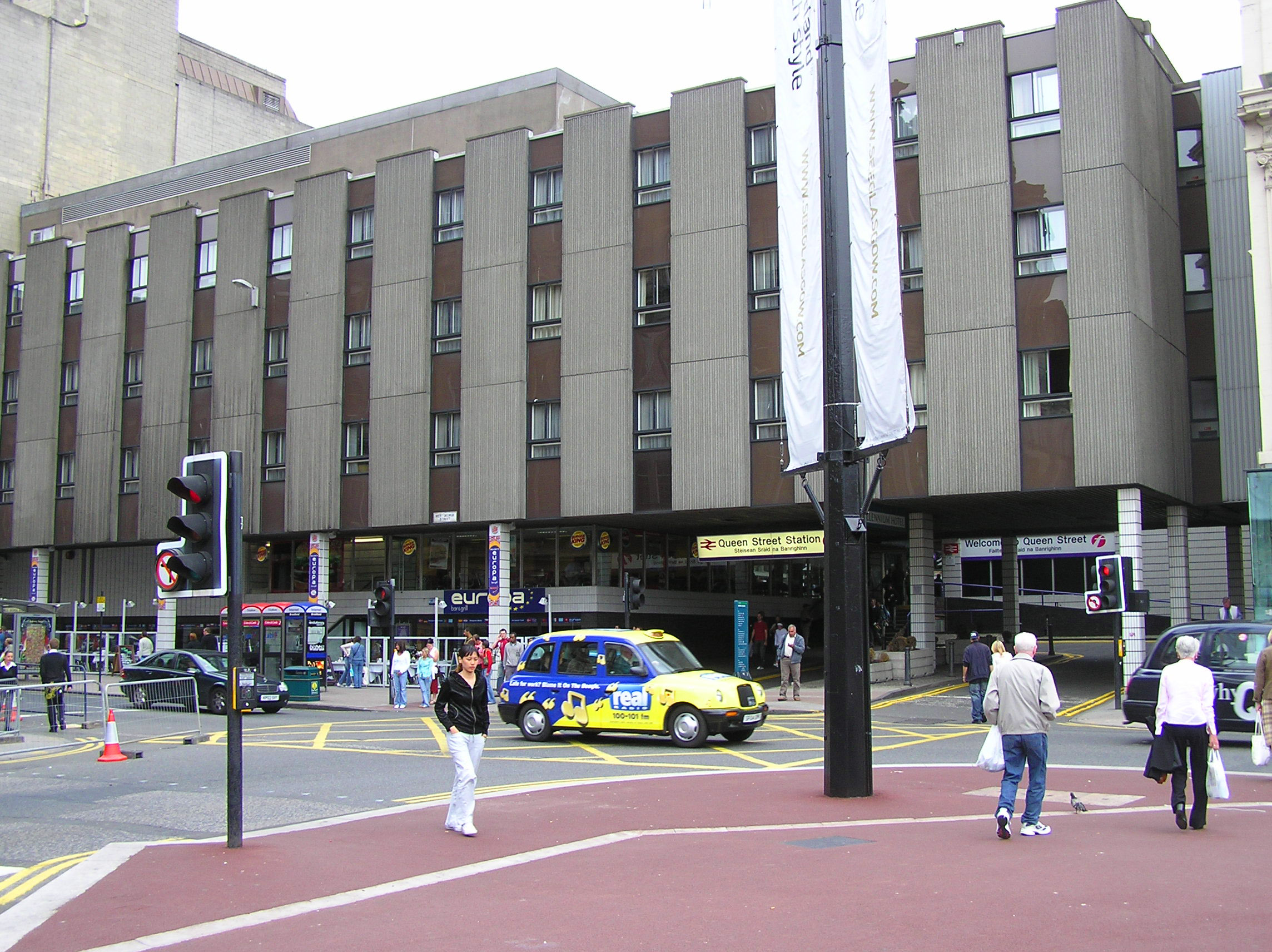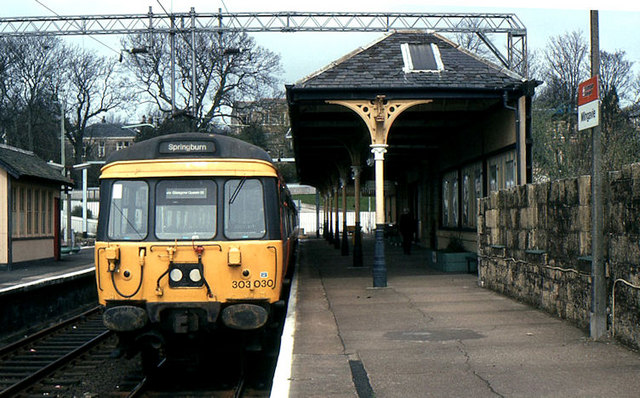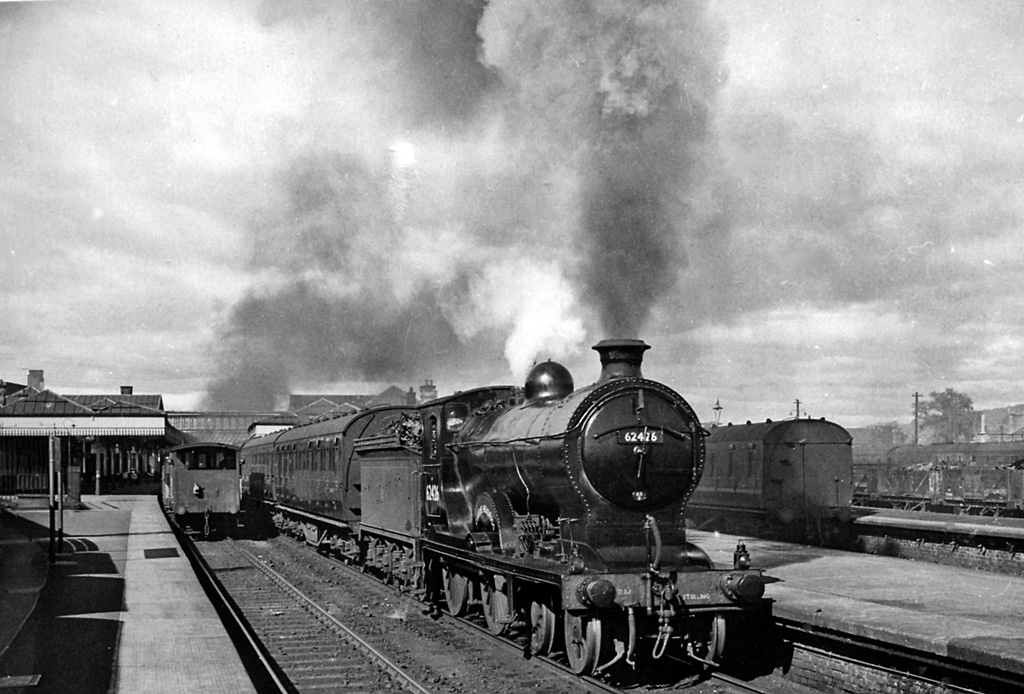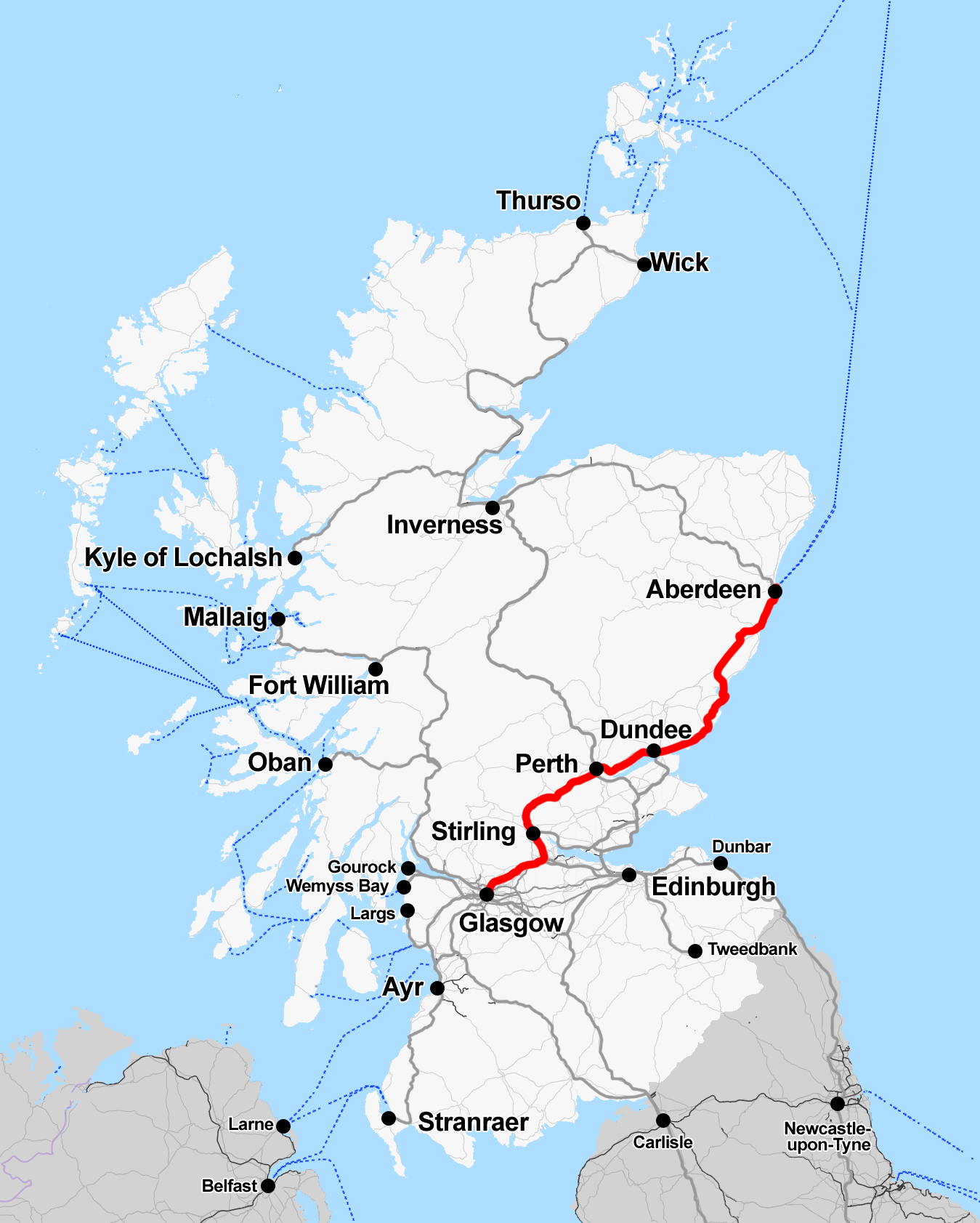|
Glasgow Queen Street Railway Station
Glasgow Queen Street () is a passenger railway terminus serving the city centre of Glasgow, Scotland. It is the smaller of the city's two mainline railway terminals (the larger being Glasgow Central) and is the third-busiest station in Scotland behind Central and Edinburgh Waverley (). The station serves mainly destinations in the Central Belt and Highlands of Scotland, with Glasgow Central covering destinations in the Lowlands of Scotland, and cross-border services into England. Major lines on the station's terminal high-level platforms include the Glasgow-Edinburgh via Falkirk line to Edinburgh Waverley, the principal and fastest route from Glasgow-Edinburgh. Other lines include the West Highland Line for services to and from Oban, Fort William and Mallaig, as well as the Highland Main Line and Glasgow–Dundee line for services to Stirling, Perth, Inverness, Dundee and Aberdeen. On the station's through low-level platforms is the suburban North Clyde line, running Wes ... [...More Info...] [...Related Items...] OR: [Wikipedia] [Google] [Baidu] |
Glasgow
Glasgow is the Cities of Scotland, most populous city in Scotland, located on the banks of the River Clyde in Strathclyde, west central Scotland. It is the List of cities in the United Kingdom, third-most-populous city in the United Kingdom and the 27th-most-populous city in Europe, and comprises Wards of Glasgow, 23 wards which represent the areas of the city within Glasgow City Council. Glasgow is a leading city in Scotland for finance, shopping, industry, culture and fashion, and was commonly referred to as the "second city of the British Empire" for much of the Victorian era, Victorian and Edwardian eras. In , it had an estimated population as a defined locality of . More than 1,000,000 people live in the Greater Glasgow contiguous urban area, while the wider Glasgow City Region is home to more than 1,800,000 people (its defined functional urban area total was almost the same in 2020), around a third of Scotland's population. The city has a population density of 3,562 p ... [...More Info...] [...Related Items...] OR: [Wikipedia] [Google] [Baidu] |
Glasgow–Edinburgh Lines
There are four electrified railway lines linking Glasgow with Edinburgh, the two largest cities in Scotland. These are, from north to south: * Glasgow–Edinburgh via Falkirk line: Glasgow Queen Street to Edinburgh Waverley via Falkirk High *North Clyde Line: Glasgow Queen Street (low level platforms) to Edinburgh Waverley via Airdrie and Bathgate *Shotts Line: Glasgow Central to Edinburgh Waverley via Shotts * Glasgow–Edinburgh via Carstairs line: Glasgow Central to Edinburgh Waverley via Carstairs Historically, the first line between Glasgow and Edinburgh was the Edinburgh and Glasgow Railway, equivalent to today's Glasgow to Edinburgh via Falkirk Line. Former routes Glasgow–Edinburgh via Cumbernauld line: used the Cumbernauld Line from Glasgow Queen Street, and the Edinburgh–Dunblane line. The use of this line as a secondary route between Glasgow and Edinburgh was introduced as part of the December 2018 timetable and later removed. Services now only go as far a ... [...More Info...] [...Related Items...] OR: [Wikipedia] [Google] [Baidu] |
Dumbarton Central Railway Station
Dumbarton Central railway station serves the town of Dumbarton in West Dunbartonshire, Scotland. This station is on the West Highland Line and the North Clyde Line, northwest of . History The station was opened on 15 July 1850 by the Caledonian and Dumbartonshire Junction Railway on their route from to , where travellers could join steamships on the River Clyde to get to Glasgow. Connections with the Glasgow, Dumbarton and Helensburgh Railway at Dalreoch Junction and at Bowling put the station on a through route between and by 1858. The company was subsequently absorbed by the Edinburgh and Glasgow Railway in 1862 and eventually became part of the North British Railway three years later. However, in 1891, the North British was forced to come to an agreement with the rival Caledonian Railway to give the latter access to Balloch (and the Loch Lomond steamships) over C&DJR metals in order to prevent the building of a competing route by the Caledonian company - this resulted ... [...More Info...] [...Related Items...] OR: [Wikipedia] [Google] [Baidu] |
Milngavie Railway Station
Milngavie railway station serves the town of Milngavie, East Dunbartonshire, near Glasgow in Scotland. The station is sited from Glasgow Queen Street, measured via Maryhill. The station is managed by ScotRail, who also operate all services at the station, along the North Clyde and Argyle lines. Its principal purpose today is as a commuter station for people working in Glasgow city centre. The station itself is a category B listed building. History The station was opened in April 1863, and was then part of the Glasgow and Milngavie Junction Railway. Originally built with three platforms, one platform has since been removed. The land where the third platform once stood has been sold. The line was doubled in 1900, but was singled again in 1990. During December 2020, the long platforms were extended to by reinstating of unused platform and adding a further of new platform. The project cost £5 million. Location The station is the usual access point for the long W ... [...More Info...] [...Related Items...] OR: [Wikipedia] [Google] [Baidu] |
North Clyde Line
The North Clyde Line (defined by Network Rail as the ''Glasgow North Electric Suburban'' line) is a suburban railway in West Central Scotland. The route is operated by ScotRail. As a result of the incorporation of the Airdrie–Bathgate rail link and the Edinburgh–Bathgate line, this route has become the fourth rail link between Glasgow and Edinburgh. Route The North Clyde Line (known as Dunbartonshire - Glasgow, Cumbernauld and Falkirk Grahamston in timetables), electrified by British Rail in 1960, ran east–west through the Greater Glasgow conurbation, linking northern Lanarkshire with western Dunbartonshire, by way of the city centre. Fifty years later, in 2010, the line was extended by Network Rail east from Airdrie, by way of re-opening the line to Bathgate meeting up with the line re-opened by British Rail from Edinburgh. The main core of the route runs from to via and Glasgow Queen Street (Low Level). To the east of the Glasgow city centre, there is a sho ... [...More Info...] [...Related Items...] OR: [Wikipedia] [Google] [Baidu] |
Aberdeen Railway Station
Aberdeen railway station is the main railway station in Aberdeen, Scotland. It is the busiest railway station in Scotland north of the major cities of Edinburgh and Glasgow. It is located on Guild Street in the city centre, next to Union Square. The station is managed by ScotRail. Inter-city, regional, local and sleeper train services are provided to all parts of Great Britain by ScotRail, Caledonian Sleeper, CrossCountry and London North Eastern Railway. The station is the northern terminus of the Dundee–Aberdeen line and the southern terminus of the Aberdeen–Inverness line, and is measured from Carlisle via Perth. History Pre-nationalisation The station currently standing was built and opened in 1867, although the station today has been significantly redeveloped from the original. The station and the new Denburn Valley Line enabled the main line from the south and the commuter line from Deeside to connect with the line from the north. The lines from the south h ... [...More Info...] [...Related Items...] OR: [Wikipedia] [Google] [Baidu] |
Dundee And Newtyle Railway
The Dundee and Newtyle Railway opened in 1831 and was the first railway in the north of Scotland. It was built to carry goods between Dundee and the fertile area known as Strathmore, Angus, Strathmore; this involved crossing the Sidlaw Hills, and was accomplished with three Cable railway, rope-worked inclined planes. Newtyle was simply a remote railhead, and the anticipated traffic volumes were not achieved, the inclines incurred heavy operating costs, and the railway never made money. Responding to the criticism of the remote Newtyle station, two further railways were built; these were nominally independent but for practical purposes were branches of the Dundee line. The lines were the ''Newtyle and Coupar Angus Railway'' and the ''Newtyle and Glammiss Railway''; they opened in 1837 - 1838. The extension lines did not transform the finances of the main railway, but when the Scottish Midland Junction Railway wanted to build a main line between Perth and Forfar, it adopted the ... [...More Info...] [...Related Items...] OR: [Wikipedia] [Google] [Baidu] |
Inverness Railway Station
Inverness railway station serves the Scottish city of Inverness. It is the terminus of the Highland Main Line, the Aberdeen–Inverness line (of which the Inverness and Nairn Railway is now a part), the Kyle of Lochalsh line and the Far North Line. The Aberdeen and Perth lines diverge at ''Millburn Junction'' a short distance beyond Welsh's Bridge. Platforms 1–4 are from (measured via ); Millburn Junction, from Perth (or via ). The station is the zero point for the Far North Line and platforms 5–7 are along this line; Rose Street Junction, along the line, is from Perth. History Inverness station was opened on 5 November 1855 as the western terminus of the Inverness and Nairn Railway to designs by the architect, Joseph Mitchell. The station originally comprised a single covered passenger platform with three lines of rails, one for arrivals, one for departures and a spare line for carriages. In 1857 the railway company erected a clock in front of the station fac ... [...More Info...] [...Related Items...] OR: [Wikipedia] [Google] [Baidu] |
Perth Railway Station (Scotland)
Perth railway station is a railway station located in the city of Perth, Scotland, on both the Glasgow to Dundee line and the Highland Main Line. It is managed by ScotRail, who provide almost all of the services (along with LNER and the Caledonian Sleeper). It is sited from Carlisle, measured via Stirling, Cumbernauld and Motherwell, and approximately from Ladybank (thus approximately from Edinburgh Waverley via Kirkcaldy and Inverkeithing). History Openings The station was opened (as Perth General Station) by the Scottish Central Railway (SCR) in 1848 to a design by William Tite. Originally the terminus of the SCR main line from Greenhill Junction near Glasgow, it soon became a junction of some importance with the arrival of the Dundee and Perth Railway from Dundee (following the completion of Tay Viaduct, a bridge across the River Tay), the Edinburgh and Northern Railway (E&NR) from on the Fife coast and the Scottish Midland Junction Railway (SMJR) from with ... [...More Info...] [...Related Items...] OR: [Wikipedia] [Google] [Baidu] |
Stirling Railway Station (Scotland)
Stirling railway station is a railway station located in Stirling, Scotland. It is located on the former Caledonian Railway main line between Glasgow and Perth, Scotland, Perth. It is the junction for the branch line to and is also served by trains on the Edinburgh to Dunblane Line and long-distance services to Dundee and Aberdeen and to Inverness via the Highland Main Line. History Stirling was first connected to the Scottish Central Railway, with southbound services to Upper Greenhill railway station, Greenhill commencing on 1 March 1848 and northbound services to Perth railway station (Scotland), Perth on 22 May 1848. In 1853 the Stirling and Dunfermline Railway opened a station known as Stirling East, directly next to the main station. The Forth and Clyde Junction Railway opened a line to three years later serving the main station. Through services to/from the Callander and Oban Railway also served the station from 1870. Following a competition, the current station bu ... [...More Info...] [...Related Items...] OR: [Wikipedia] [Google] [Baidu] |
Glasgow–Dundee Line
The Glasgow–Dundee line is a railway line linking Glasgow with Dundee via Stirling and Perth. Route Most of the route is shared with other services: * Glasgow–Edinburgh via Falkirk line between Glasgow Queen Street and Greenhill Junction * Croy Line between Glasgow Queen Street and Dunblane * Edinburgh–Dunblane line between Larbert and Dunblane Stations Historical route The route comprises the following historical railway lines: * Edinburgh and Glasgow Railway between Glasgow Queen Street and Greenhill Junction (between Croy and Larbert) * Scottish Central Railway between Greenhill Junction and Perth * Dundee and Perth Railway between Perth and Dundee Services From December 2008 There is generally an hourly service throughout the day between Glasgow and Aberdeen. In the May 2016 timetable, there are also a few additional services between Glasgow & Dundee which offer connections at the latter for stations further north. Three trains work north of Aberdeen as part o ... [...More Info...] [...Related Items...] OR: [Wikipedia] [Google] [Baidu] |
Highland Main Line
The Highland Main Line is a railway line in Scotland. It is long and runs through the central Scottish Highlands, mainly following the route of the A9 road (Scotland), A9, and linking a series of small towns and villages with Perth, Scotland, Perth at one end and Inverness at the other. Today, services between Inverness and Edinburgh, Glasgow and London use the line. At Inverness the line connects with the Far North Line, the Aberdeen to Inverness Line, Aberdeen-Inverness Line and the Kyle of Lochalsh Line. Much of the Highland Main Line is Single track (rail), single track, and trains coming in opposite directions are often timed to arrive at stations at the same time, where Passing loop, crossing loops permit them to pass. Journey times between Inverness and Edinburgh or Glasgow are approximately three and a half hours.Highland Main Line timetables at https://www.scotrail.co.uk/sites/default/files/assets/download_ct/edinburgh_glasgow_-_inverness_0.pdf History The vast ... [...More Info...] [...Related Items...] OR: [Wikipedia] [Google] [Baidu] |









